The Kokomo Metro Area
The Area
Take U.S. 31 north out of Indianapolis and you’ll find yourself in Kokomo. Howard and Tipton counties form the Kokomo Metropolitan Area (metro), with 101,220 residents, as of the latest 2004 estimates. Cities and towns in the region include Kokomo, Tipton, Greentown and Russiaville. Tipton County is by far the more rural of the two, ranking 79th out of 92 Indiana counties by population size. Howard County ranks 18th statewide, and has nearly 84 percent of the metro’s population.
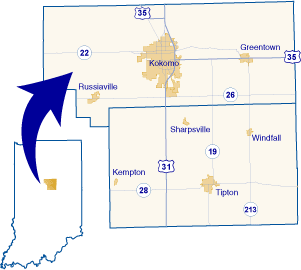
Since Census 2000, the Kokomo metro has lost about 300 people due to net out-migration. While natural increase (births minus deaths) and international migration added 1,474 new residents, net domestic migration saw more than 1,700 move away. At the county level, Tipton County has seen a slight increase in total population.
Projections from the Indiana Business Research Center indicate that the metro will grow 1.1 percent from current levels by 2020, compared to an 8.1 percent growth statewide. All age groups below 45 years old will decline, with the greatest loss concentrated in the 25-44 age group. The number of senior citizens over age 65 will increase 37 percent from Census 2000 levels.
Industrial Mix and Jobs
One-third of Kokomo employment is found in the manufacturing sector, significantly higher than the state’s 20 percent. Retail trade followed as the next largest sector in the metro with 12.8 percent of total employment in the third quarter of 2004.
Major regional employers are shown in Table 1. Delphi Electronics and Safety in Kokomo, the largest employer, manufactures electronics for vehicles and has broken into the satellite radio market, illustrating how the company has transitioned into new and expanding markets.
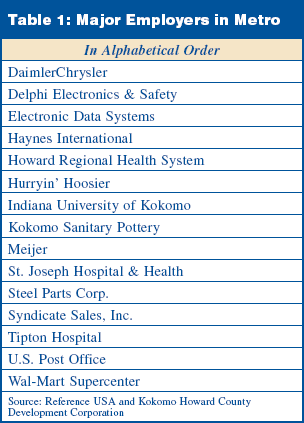
Nevertheless, Delphi, the parent company in Michigan, is under investigation by the Securities and Exchange Commission for accounting improprieties and has experienced a downgrading of its credit rating and a drop in stock price. According to the Indianapolis Business Journal, Delphi, with its divisions in Kokomo, Anderson and Indianapolis, is the 10th largest employer in the state.(1)
Primarily because of expansions of the DaimlerChrysler plant, Expansion Management ranked the Kokomo metro first in the nation for European investments in 2004.(2)
Figure 1 shows the movements in total employment since 2001. Employment peaked in the second quarter of 2001 at 53,481 and has since settled at 49,394, and as a result, unemployment rates have edged back up to the levels seen prior to the boom of the late 1990s.
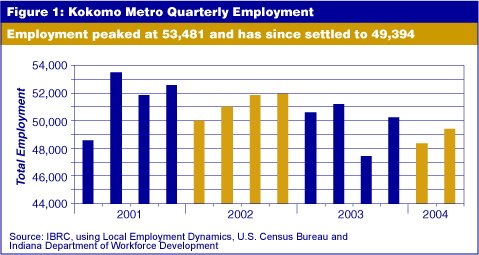
When looking specifically at manufacturing, employment peaked in the second quarter of 2002 at nearly 21,300 jobs. By the second quarter of 2004, total manufacturing employment had dropped to just over 17,300.
The number of new jobs created in the metro has slowly edged upward, although not fast enough to fill the void left by employment declines in established businesses. Industries with the most new job creation between the first quarters of 2001 and 2004 include manufacturing, retail trade and health care (see Figure 2). Manufacturing goes to the top of the list due to a large job creation (4,319 jobs) in the first quarter of 2001, which accounted for more than 70 percent of the new manufacturing jobs added during those three years.
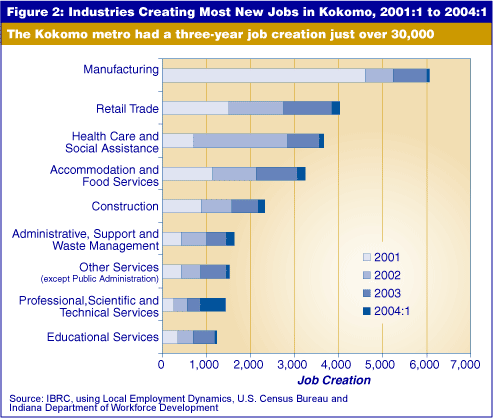
Census 2000 tells us that 18.1 percent of Howard County residents and 12.4 percent of Tipton County residents have a bachelor’s degree or higher. A survey prepared for the Kokomo Howard County Development Corporation (2000) indicated that about 15 percent of the labor force in the broader north-central Indiana region (3) was underemployed, meaning they possess the skills, education and experience to qualify them for a better job. About 39 percent of those underemployed individuals had some college experience while about 12 percent had a bachelor’s degree or higher. Lower levels of employment coupled with the recent disparities between average wages and new hire wages indicate that underemployment is still a problem facing the region. However, this reserve of educated workers could also be considered an opportunity, depending on how one frames the issue.
Commuting
Over 14,900 people commute into Howard County to work according to the preliminary data for 2003 from STATS Indiana. About 3,700 residents leave the county to work elsewhere, while over 53,000 live and work in the county (see Figure 3).
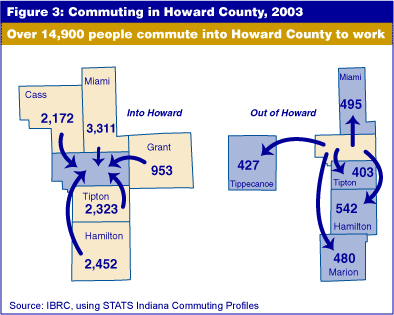
Compensation
New hires in Howard County earned just 39 percent of the county’s average wage for 2003, ranking it last among counties statewide on this indicator. During 2001, new hires in the Kokomo metro earned about $570 less than the overall average wage in the metro. This small gap is attributable largely to the high levels of new manufacturing jobs created in the first half of the year. For 2002, the gap had grown to just over $2,000, and by 2003, new hires were earning over $2,200 less than the county average, confirming that high-paying manufacturing jobs are being replaced with lower-paying jobs (see Figure 4).
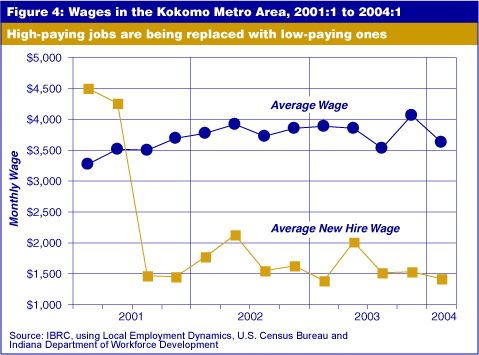
Nevertheless, when looking at total compensation for 2003, which includes wages plus employer contributions for insurance, pension funds and government social insurance, Kokomo came in at $60,704, about $19,000 higher than the Indiana average and about $15,000 higher than the Indianapolis metro area. In fact, Howard County had the highest average compensation per job in the state and one of the highest nationwide.
Between 2001 and 2003, the metro’s average compensation per job grew by nearly $11,800. The bulk of this was in the form of employer pension contributions and insurance benefits, which more than doubled during those two years, dramatically faster than seen statewide. Wages, meanwhile, grew just 1.8 percent, about half as fast as in the state overall.
In sum, workers in Kokomo brought in nearly $3.1 billion in 2003 (67 percent were in the form of actual wages and salary disbursements), up from $2.6 billion two years earlier. At the industry level, compensation since 2001 grew an impressive 187 percent in management of companies and enterprises to reach $1.6 million. Although that sector had the largest percentage increase, it is a mere fraction of the compensation paid out in the manufacturing industry, which grew 27 percent to exceed $2 billion. This accounted for 66 percent of all compensation in the metro, proving once again that manufacturing still dominates the Kokomo economy.
Notes
- “2005 Book of Lists.” Indianapolis Business Journal 25 (41): 76.
- Ken Krizner and Rachael Hedgcoth, “2004 Top U.S. Metros for European Expansion,” Expansion Management 18 July 2004; available online at www.expansionmanagement.com/emstatic/research/europeanexpansion.asp
- The study area included Carroll, Cass, Clinton, Grant, Howard, Miami and Tipton counties and the full report is accessible online at http://khdc.org/news_archive.php
Rachel Justis
Managing Editor, Indiana Business Research Center,
Kelley School of Business, Indiana University
